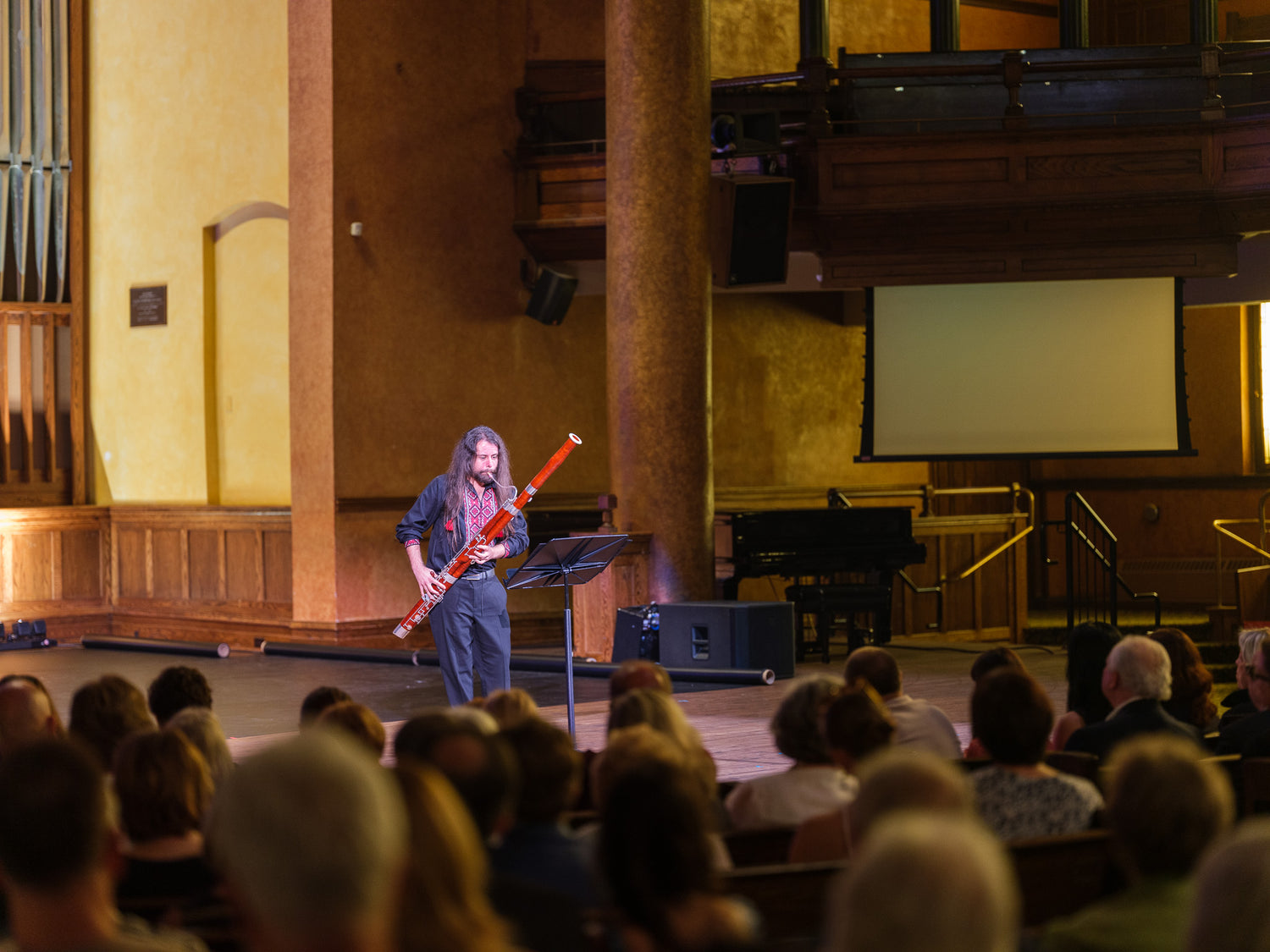Slava Ukraini Series
"Slava Ukraini" (Слава Україні) means "Glory to Ukraine!" It traces its origin from Taras Shevchenko's poetry in the 1840s, and has been a rallying cry of the Ukrainian people at least since the early 20th century. The phrase has since made a comeback in recent years since the Russian invasion of Crimea, Donbas, Donetsk and Luhansk in 2014. We thought this simple, powerful phrase was a fitting title for our Ukrainian music series, where we seek to shine a spotlight on the vibrant and diverse musical landscape of Ukraine and the Ukrainian diaspora. Revenues from the sales of Slava Ukraini titles go directly to the composers and/or their families.
The main driving force behind this series is my friend, bassoonist and scholar of Ukrainian music Zachary Senick (Захар Сенюк). He is originally from Saskatoon, Saskatchewan, an epicenter of the global Ukrainian diaspora. His connections with his roots have put him in touch with many Ukrainian composers, or their closest living relative, and allowed him to track down many musical gems that have often not been given their due.

SASKATOON, SASKATCHEWAN: Taran and Zachary, the editing team behind the ép Slava Ukraini series (we both look great in a vyshyvanka, don't you think??).
One of the most important pieces of this project is ensuring these scores are as accessible and performer-friendly as possible, removing significant barriers to their performance. As a result, we do not simply publish a digitized facsimile of the manuscript; each piece undergoes an engraving process that can take around 2 weeks to 2-3 months.
Most of these works initially exist only in handwritten form. Zachary begins the process of digitization by entering every detail into free scoring application MuseScore. It is then passed to the ép team for conversion to our house templates in Steinberg Dorico using MusicXML.
The next step, the longest by far, is the revisions process. The now-digitized score is passed back and forth along with dozens of pages of notes about potential improvements, clarifications, and error corrections. Some minor changes are usually necessary to conform to best notational practices, but we strive to ensure the composer's intentions are represented as accurately as possible. Every single detail of the music is scrutinized, and Zachary consults with the composer directly if possible to clear up any ambiguities in the score.

A sample page from Maryna Denysenko's "Pentavox" Wind Quintet.
Typically, after four or five revision passes, we have resolved all of the notes in the score, and it is ready for part preparation. Cues are added to aid ensemble coordination and layout is given special consideration to facilitate page turns. This can (but doesn't always) result in another round of revision notes on the score.
Finally, when the notation is settled, we compile the score with its front matter: A cover page, an introduction page, and any other information that may be relevant to the piece. These composers are relatively unknown outside Ukraine, so Zachary has included a detailed biography in each publication for the performers' reference.
In April 2025, Zach successfully defended his doctoral dissertation, "Slava Ukraini: An Annotated Catalogue of Ukrainian Solo and Chamber Works for Bassoon." He has made his invaluable work publicly available on the Ukrainian Chamber Music Encyclopedia website and will continue to update it into the future.
You can find more about the series on Zach's blog article below, or browse the collection yourself. We strive to add new titles every 1-2 months, so check back often!

ép blog
Zachary Senick: Uncovering Ukrainian chamber music
Ukrainian classical music has a long history dating back to what is now termed as the “Cossack Baroque” that was inspired by folk elements with the popular genre of Duma emerging...
Slava Ukraini Series publications
-
Oleksandr Albul's Little Suite for Wind Quintet [Digital Version]
Regular price $28.00 CADRegular price -
Volodymyr Chernenko's Ballada Ukrainian Pattern for bassoon and piano [Digital Download]
Regular price $12.00 CADRegular price -
Oleksandr Zhylinskyi's "Fagotina" for bassoon and piano [Digital Download]
Regular price $14.00 CADRegular price -
Maryna Denysenko's Quintet for Winds “Pentavox” [Digital Download]
Regular price $34.00 CADRegular price


![Oleksandr Albul's Little Suite for Wind Quintet [Digital Version]](http://editionsplamondon.com/cdn/shop/files/ALBUL-SUITE_01_digital.png?v=1718756279&width=533)
![Oleksandr Albul's Little Suite for Wind Quintet [Digital Version]](http://editionsplamondon.com/cdn/shop/files/ALBUL-SUITE_02.png?v=1718756279&width=533)
![Volodymyr Chernenko's Ballada Ukrainian Pattern for bassoon and piano [Digital Download]](http://editionsplamondon.com/cdn/shop/files/CHRN-BALLAD_01_digital.png?v=1749354570&width=533)
![Volodymyr Chernenko's Ballada Ukrainian Pattern for bassoon and piano [Digital Download]](http://editionsplamondon.com/cdn/shop/files/CHRN-BALLAD_02.png?v=1749354570&width=533)
![Oleksandr Zhylinskyi's "Fagotina" for bassoon and piano [Digital Download]](http://editionsplamondon.com/cdn/shop/files/ZHYLI-FGTNA_01_digital.png?v=1746751904&width=533)
![Oleksandr Zhylinskyi's "Fagotina" for bassoon and piano [Digital Download]](http://editionsplamondon.com/cdn/shop/files/ZHYLI-FGTNA_02.png?v=1749341106&width=533)
![Maryna Denysenko's Quintet for Winds “Pentavox” [Digital Download]](http://editionsplamondon.com/cdn/shop/files/DENYS-PENTA_01_digital.png?v=1721799492&width=533)
![Maryna Denysenko's Quintet for Winds “Pentavox” [Digital Download]](http://editionsplamondon.com/cdn/shop/files/DENYS-PENTA_02.png?v=1721799268&width=533)